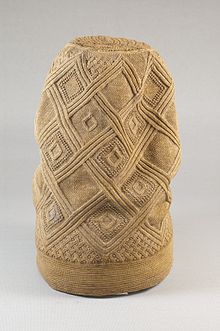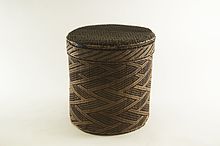
Weaving is a method of textile production in which two distinct sets of yarns or threads are interlaced at right angles to form a fabric or cloth. Other methods are knitting, crocheting, felting, and braiding or plaiting. The longitudinal threads are called the warp and the lateral threads are the weft, woof, or filling. The method in which these threads are interwoven affects the characteristics of the cloth. Cloth is usually woven on a loom, a device that holds the warp threads in place while filling threads are woven through them. A fabric band that meets this definition of cloth can also be made using other methods, including tablet weaving, back strap loom, or other techniques that can be done without looms.

Velvet is a type of woven fabric with a dense, even pile that gives it a distinctive soft feel. By extension, the word velvety means "smooth like velvet". Historically, velvet was typically made from silk. Today, velvet can be made from silk, linen, cotton, wool, synthetic fibers, silk-cotton blends, or synthetic-natural fiber blends.
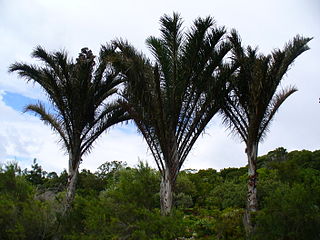
Raffia palms are a genus of about twenty species of palms native to tropical regions of Africa, and especially Madagascar, with one species also occurring in Central and South America. R. taedigera is the source of raffia fibers, which are the veins of the leaves, and this species produces a fruit called "brazilia pods", "uxi nuts" or "uxi pods".

Damask is a reversible patterned fabric of silk, wool, linen, cotton, or synthetic fibers, with a pattern formed by weaving. Damasks are woven with one warp yarn and one weft yarn, usually with the pattern in warp-faced satin weave and the ground in weft-faced or sateen weave. Twill damasks include a twill-woven ground or pattern.
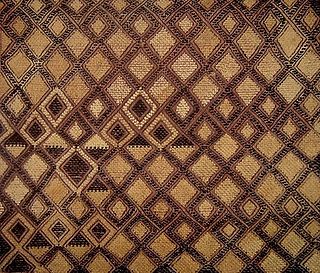
Velours du Kasaï is a kind of textile fabric made in Kasai, a province in the Democratic Republic of the Congo (Zaïre). Traditionally, the weaving is done by men of the Shoowa from the Kuba ethnic group, while the embroidery is reserved to women. Ideally, the embroiderers should be pregnant. The technique is still practised.

Textile design, also known as textile geometry, is the creative and technical process by which thread or yarn fibers are interlaced to form a piece of cloth or fabric, which is subsequently printed upon or otherwise adorned. Textile design is further broken down into three major disciplines: printed textile design, woven textile design, and mixed media textile design. Each uses different methods to produce a fabric for variable uses and markets. Textile design as an industry is involved in other disciplines such as fashion, interior design, and fine arts.

The Kuba Kingdom, also known as the Kingdom of the Bakuba or Bushongo, is a traditional kingdom in Central Africa. The Kuba Kingdom flourished between the 17th and 19th centuries in the region bordered by the Sankuru, Lulua, and Kasai rivers in the heart of the modern-day Democratic Republic of the Congo.
The manufacture of textiles is one of the oldest of human technologies. To make textiles, the first requirement is a source of fiber from which a yarn can be made, primarily by spinning. The yarn is processed by knitting or weaving, which turns yarn into cloth. The machine used for weaving is the loom. For decoration, the process of colouring yarn or the finished material is dyeing. For more information of the various steps, see textile manufacturing.
The study of the history of clothing and textiles traces the development, use, and availability of clothing and textiles over human history. Clothing and textiles reflect the materials and technologies available in different civilizations at different times. The variety and distribution of clothing and textiles within a society reveal social customs and culture.
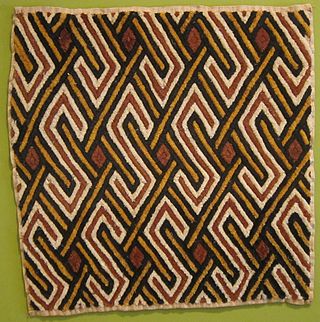
African textiles are textiles from various locations across the African continent. Across Africa, there are many distinctive styles, techniques, dyeing methods, and decorative and functional purposes. These textiles hold cultural significance and also have significance as historical documents of African design.
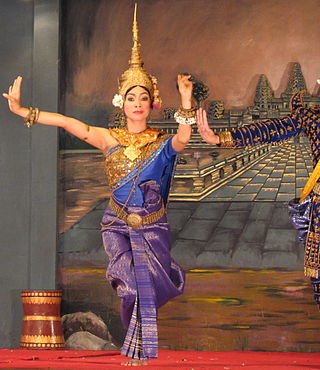
A sampot, a long, rectangular cloth worn around the lower body, is a traditional dress in Cambodia. It can be draped and folded in several different ways. The traditional dress is similar to the dhoti of Southern Asia. It is also worn in the neighboring countries of Laos and Thailand where it is known as pha nung.

African folk art consists of a variety of items: household objects, metal objects, toys, textiles, masks, and wood sculpture. Most traditional African art meets many definitions of folk art generally, or at least did so until relatively recent dates.

The Andean textile tradition once spanned from the Pre-Columbian to the Colonial era throughout the western coast of South America, but was mainly concentrated in Peru. The arid desert conditions along the coast of Peru have allowed for the preservation of these dyed textiles, which can date to 6000 years old. Many of the surviving textile samples were from funerary bundles, however, these textiles also encompassed a variety of functions. These functions included the use of woven textiles for ceremonial clothing or cloth armor as well as knotted fibers for record-keeping. The textile arts were instrumental in political negotiations, and were used as diplomatic tools that were exchanged between groups. Textiles were also used to communicate wealth, social status, and regional affiliation with others. The cultural emphasis on the textile arts was often based on the believed spiritual and metaphysical qualities of the origins of materials used, as well as cosmological and symbolic messages within the visual appearance of the textiles. Traditionally, the thread used for textiles was spun from indigenous cotton plants, as well as alpaca and llama wool.

Herringbone, also called broken twill weave, describes a distinctive V-shaped weaving pattern usually found in twill fabric. It is distinguished from a plain chevron by the break at reversal, which makes it resemble a broken zigzag. The pattern is called herringbone because it resembles the skeleton of a herring fish. Herringbone-patterned fabric is usually wool, and is one of the most popular cloths used for suits and outerwear. Tweed cloth is often woven with a herringbone pattern.
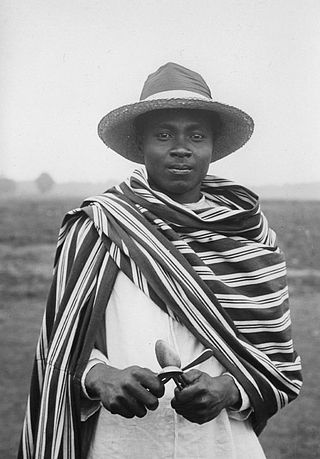
A lamba is the traditional garment worn by men and women that live in Madagascar. The textile, highly emblematic of Malagasy culture, consists of a rectangular length of cloth wrapped around the body.

Akwete cloth is a hand woven textile produced in Igboland for which the town of Akwete, also known as Ndoki, both which the cloth was named after in Abia state, Nigeria is famous. Alternative names include "Aruru" meaning "something woven", "Mkpuru Akwete" and "Akwete fabric". This traditional Igbo weaving processes sisal, hemp, raffia, cotton or other fibres into finished products. While the coarse raffia materials are used by masquerades and in the past as headgear for warriors among other uses, the hemp material was used to weave towels, ropes and handbags. The more comfortable and colorful spun cotton is used to weave cloth for everyday wearing. Akwete cloths contain many motifs. Today, women continue to produce Akwete cloth for a wide, global market.

Kuba art comprises a diverse array of media, much of which was created for the courts of chiefs and kings of the Kuba Kingdom. Such work often featured decorations, incorporating cowrie shells and animal skins as symbols of wealth, prestige and power. Masks are also important to the Kuba. They are used both in the rituals of the court and in the initiation of boys into adulthood, as well as at funerals. The Kuba produce embroidered raffia textiles which in the past was made for adornment, woven currency, or as tributary goods for funerals and other seminal occasions. The wealth and power of the court system allowed the Kuba to develop a class of professional artisans who worked primarily for the courts but also produced objects of high quality for other individuals of high status.
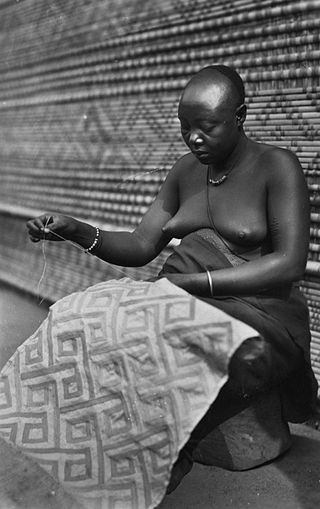
Kuba textiles are a type of raffia cloth unique to the Democratic Republic of the Congo, formerly Zaire, and noted for their elaboration and complexity of design and surface decoration. Most textiles are a variation on rectangular or square pieces of woven palm leaf fiber enhanced by geometric designs executed in linear embroidery and other stitches, which are cut to form pile surfaces resembling velvet. Traditionally, men weave the raffia cloth, and women are responsible for transforming it into various forms of textiles, including ceremonial skirts, ‘velvet’ tribute cloths, headdresses and basketry.
Malagasy weaving flourished until around 1950. Due to varied ecology in Madagascar, many different materials were used to weave with and formed various styles of mainly striped cloth.
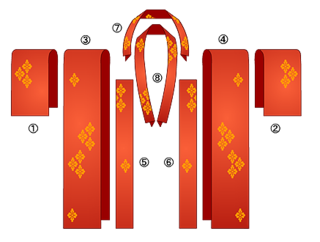
A tanmono is a bolt of traditional Japanese narrow-loomed cloth. It is used to make traditional Japanese clothes, textile room dividers, sails, and other traditional cloth items.

